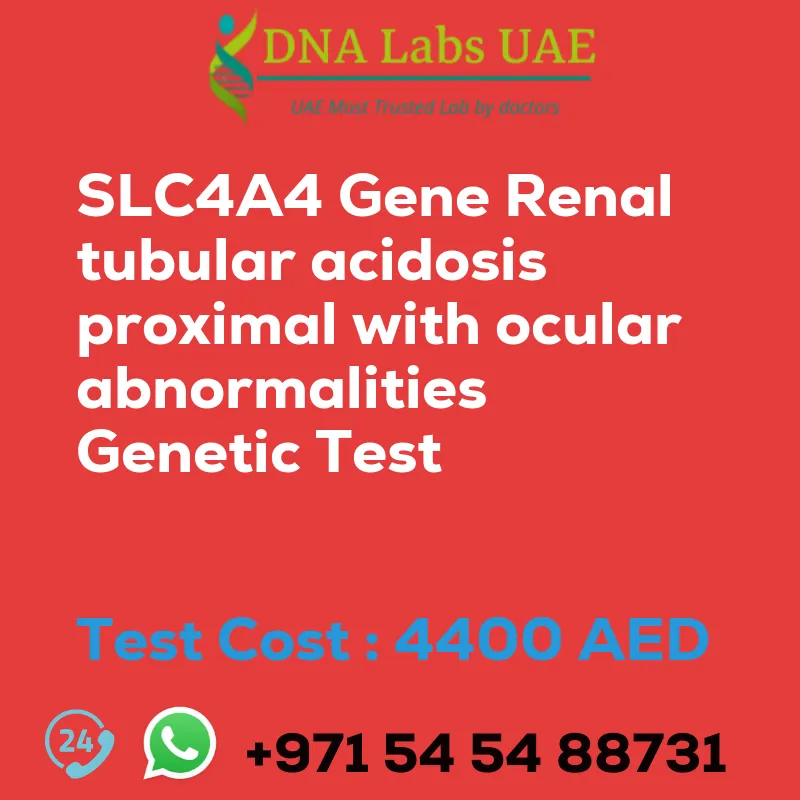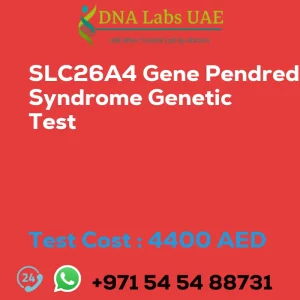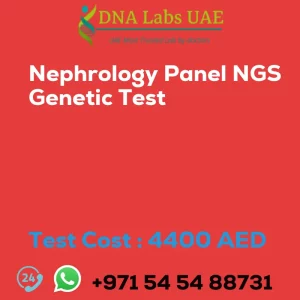SLC4A4 Gene Renal Tubular Acidosis Proximal with Ocular Abnormalities Genetic Test
Test Name: SLC4A4 Gene Renal Tubular Acidosis Proximal with Ocular Abnormalities Genetic Test
Components: Sodium bicarbonate cotransporter 1 (NBCe1) protein
Price: 4400.0 AED
Sample Condition: Blood or Extracted DNA or One drop Blood on FTA Card
Report Delivery: 3 to 4 Weeks
Method: NGS Technology
Test Type: Hepatology Nephrology Endocrinology Disorders
Doctor: General Physician
Test Department: Genetics
Pre Test Information: Clinical History of Patient who is going for SLC4A4 Gene Renal Tubular Acidosis, Proximal, with Ocular Abnormalities NGS Genetic DNA Test. A Genetic Counselling session to draw a pedigree chart of family members affected with SLC4A4 Gene Renal Tubular Acidosis, Proximal, with Ocular Abnormalities NGS Genetic DNA Test gene SLC4A4
Test Details
The SLC4A4 gene is responsible for producing a protein called sodium bicarbonate cotransporter 1 (NBCe1), which is involved in the transport of bicarbonate ions across cell membranes. Mutations in the SLC4A4 gene can lead to a condition called renal tubular acidosis, proximal, with ocular abnormalities.
Renal tubular acidosis (RTA) is a condition characterized by the inability of the kidneys to effectively remove acid from the body, leading to a buildup of acid in the blood. In proximal RTA, the dysfunction occurs in the proximal tubules of the kidneys, where bicarbonate reabsorption takes place. This leads to a decreased ability to reabsorb bicarbonate from the urine, resulting in a loss of bicarbonate and a buildup of acid in the blood.
In addition to the renal tubular acidosis, individuals with mutations in the SLC4A4 gene may also present with ocular abnormalities. These can include cataracts, glaucoma, and band keratopathy, which is the formation of a calcium deposit on the cornea.
NGS genetic testing, also known as next-generation sequencing, is a type of genetic test that can analyze multiple genes simultaneously to identify mutations or variations in the DNA sequence. It can be used to identify mutations in the SLC4A4 gene that may be causing renal tubular acidosis, proximal, with ocular abnormalities. This test can help in confirming the diagnosis, providing information about the specific mutation, and guiding treatment options.
| Test Name | SLC4A4 Gene Renal tubular acidosis proximal with ocular abnormalities Genetic Test |
|---|---|
| Components | |
| Price | 4400.0 AED |
| Sample Condition | Blood or Extracted DNA or One drop Blood on FTA Card |
| Report Delivery | 3 to 4 Weeks |
| Method | NGS Technology |
| Test type | Hepatology Nephrology Endocrinology Disorders |
| Doctor | General Physician |
| Test Department: | Genetics |
| Pre Test Information | Clinical History of Patient who is going for SLC4A4 Gene Renal tubular acidosis, proximal, with ocular abnormalities NGS Genetic DNA Test. A Genetic Counselling session to draw a pedigree chart of family members affected with SLC4A4 Gene Renal tubular acidosis, proximal, with ocular abnormalities NGS Genetic DNA Test gene SLC4A4 |
| Test Details |
The SLC4A4 gene is responsible for producing a protein called sodium bicarbonate cotransporter 1 (NBCe1), which is involved in the transport of bicarbonate ions across cell membranes. Mutations in the SLC4A4 gene can lead to a condition called renal tubular acidosis, proximal, with ocular abnormalities. Renal tubular acidosis (RTA) is a condition characterized by the inability of the kidneys to effectively remove acid from the body, leading to a buildup of acid in the blood. In proximal RTA, the dysfunction occurs in the proximal tubules of the kidneys, where bicarbonate reabsorption takes place. This leads to a decreased ability to reabsorb bicarbonate from the urine, resulting in a loss of bicarbonate and a buildup of acid in the blood. In addition to the renal tubular acidosis, individuals with mutations in the SLC4A4 gene may also present with ocular abnormalities. These can include cataracts, glaucoma, and band keratopathy, which is the formation of a calcium deposit on the cornea. NGS genetic testing, also known as next-generation sequencing, is a type of genetic test that can analyze multiple genes simultaneously to identify mutations or variations in the DNA sequence. It can be used to identify mutations in the SLC4A4 gene that may be causing renal tubular acidosis, proximal, with ocular abnormalities. This test can help in confirming the diagnosis, providing information about the specific mutation, and guiding treatment options. |








